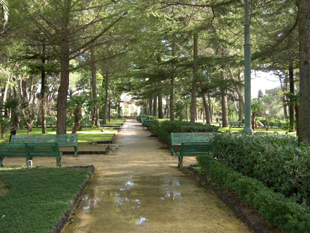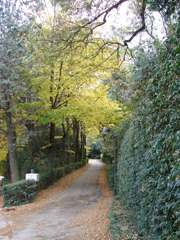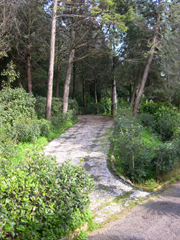
Vittorio Emanuele II Public Garden
This post is also available in:
 Italiano (Italian)
Italiano (Italian)
Vittorio Emanuele II Public Garden is located in Caltagirone (Catania). It was built in the second half of the XIX century as a decoration of Villa Real Principessa Maria delle Grazie Pia; the latter was erected by the Superintendent Amilcare Corradi to offer work opportunities to the lower classes, starting the construction in 1846. The garden was designed by Luigi Spagna in 1847, and enlarged by Michele Fragapane between 1849 and 1850; other interventions took place in 1851 by Giovan Battista Filippo Basile, to remedy some original design flaws. Basile, in fact, remodelled the existing project seeking inspiration from English informal gardens.
Today, the 163-acre garden has become a property of the municipality and is open to the public; it features three sections on three different levels: at ground level, there’s a geometrical parterre; then, there’s the wooded slope, crossed by winding paths that lead to an upper square and to a music box decorated with multicoloured tiles. Eventually, visitors can reach a large terrace with trees, fitted with a terracotta balustrade and decorated with floral motifs – it was actually built in the early XX century.
The modern-style entrance to the garden on its north-western side, facing the city, was designed by Saverio Fragapane in the 1930s.
In the garden, there are some 130 species of plants – mostly trees.
For instance, there are groups of cypresses (Cupressus sempervirens, Cupressus arizonica), Aleppo and stone pines (Pinus halepensis, Pinus pinea), ash trees (Fraxinus oxycarpa), and holm oaks (Quercus ilex).
A Pinus halepensis, with a particular shape and some 88-ft high, is the tallest tree in the garden. The rows along the paths are made of Cupressus sempervirens, C. arizonica, Pinus pinea, P. halepensis, P. roxburghii, Quercus ilex, Sophora japonica, and Tilia platyphyllos. The rows are mostly made of trees belonging to the same species; occasionally, they feature two of them, facing each other, with peculiar and striking visual effects.
The informal hedges mainly consist of Viburnum tinus, Pittosporum tobira, and Ligustrum lucidum mixed with Asparagus sprengerii, Platycladus orientalis, Pistacia lentiscus, Syrynga vulgaris, piraea x vanhouttei, Myoporum insulare, Cestrum parqui, Euonymus japonicus var. microphyllus, Lantana camara, and Plumbago capensis; the formal hedges features Buxus sempervirens, Buxus microphylla, and Laurus nobilis.
There are also several palms (Arecaceae) including Phoenix canariensis, Washingtonia robusta, Chamaerops humilis, Brahea spp., and a specimen of Butia eriospatha.
Monkey puzzles are present as well, such as Araucaria heterophylla, along with Nolina recurvata, N. longifolia, Magnolia grandiflora, Jacaranda mimosifolia, Quercus suber, Q. pubescens, Melaleuca bracteata, Citrus myrtifolia, Murraya exotica, Ceratonia siliqua, and a few naturalized exotic species mostly from the genera Ficus, Jacaranda, Erythrina, Dracaena, Melia, Chorisia, and Hibiscus.
The overall conditions of the plants are good, although some trees show visible signs of suffering, root and collar rot.
Photo source: www.giardinisiciliani.it
This post is also available in:
 Italiano (Italian)
Italiano (Italian)
Contatti
Via Giardino Vittorio Emanuele, 11 - Caltagirone (CT),(CT)
+39 0933 41363, numero verde 800011541
Altre info
ingresso gratuito
sempre aperto
dalle 8 al tramonto




